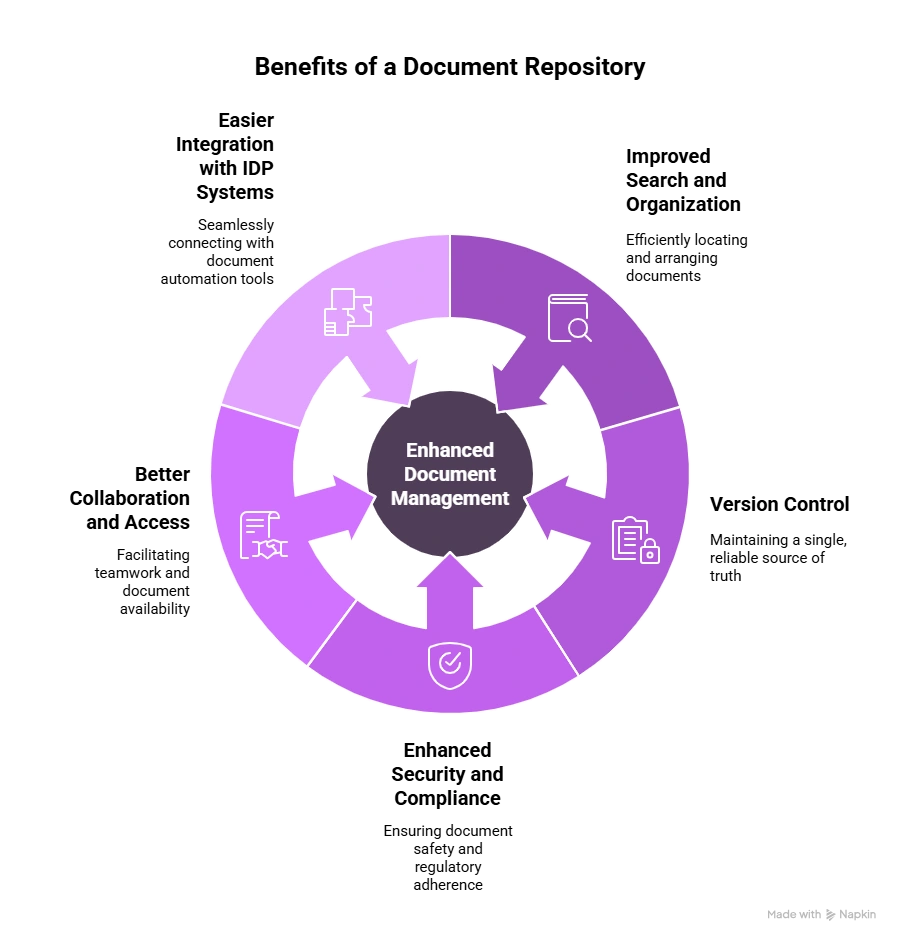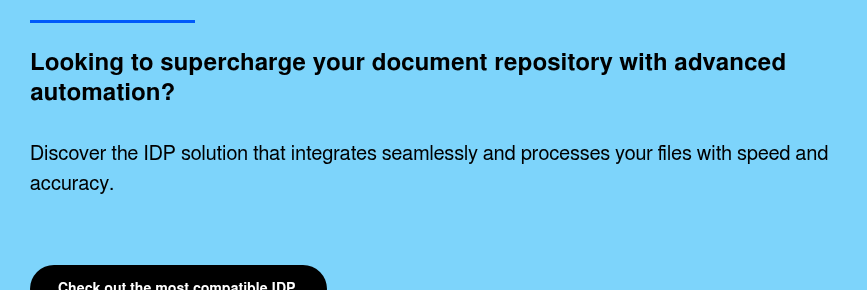In today’s fast-paced work environment, teams often waste valuable time trying to track down the right file. Documents can be scattered across email threads, shared drives, cloud platforms, and various integrations. Without consistent naming rules or version control, it’s easy to end up with duplicates or outdated copies.
The good news is the solution is simpler than you think. A well-structured Document Repository brings everything together in one place, making it much easier for teams to find, share, and work on the correct version of a file whenever they need it.
A recent IDC study shows that employees spend about 2.5 hours per day, roughly 30% of the workday, searching for information.
As a result, the average knowledge worker spends hours looking for a single file instead of focusing on productive tasks. IDC found that document-related challenges, such as misplaced files or version control issues, cause a 21.3% drop in productivity, equating to nearly $19,732 in lost output per worker per year.
83% of office workers admit to recreating documents they can’t locate on their network.
All of these points point to one clear need: better document management. One highly effective solution is implementing a document repository. But what exactly is a document repository, and how can it help?
In this article, we’ll explore:
- What is a document repository?
- What are the different types of document repositories?
- What are the benefits of having a document repository?
- Which industries need document repositories the most?
- How can you set up a document repository at minimal cost?
What is a Document Repository?
A document repository is a centralized digital storage space where an organization keeps its documents and files in an organized manner. It acts as a single source of truth for all important information. Instead of files being scattered across email attachments, personal hard drives, and various cloud folders, a document repository brings them together in one secure, organized location. Authorized employees can quickly retrieve the information they need from this shared library by searching keywords or navigating a clear folder structure.
In a well-designed repository, virtually any file format (text documents, spreadsheets, PDFs, images, etc.) can be stored in the system. In addition to storage, a good repository system provides tools to manage documents over their lifecycle. For example, version control ensures everyone is working on the latest version of a file and keeps an audit trail of changes. Repositories also enforce access permissions so that users only see or edit what they are authorized to, protecting sensitive data. In short, a document repository provides a secure, centralized environment where documents can be easily stored, found, and managed according to your company’s rules.
It's worth noting that a document repository is often a core component of a broader document management system (DMS), essentially the digital filing cabinet within a DMS. The DMS may offer additional features (workflow automation, OCR scanning, etc.), but the repository itself is the foundation that stores and organizes the files. Here, our focus is on the repository aspect: the organized digital archive that serves as the hub for all your company’s documents.
What are the Different Types of Document Repositories?
Document repositories can take several forms, depending on how they're implemented and what needs they serve. Here are a few common types of document repositories:

- Physical vs. Digital Repositories: Traditionally, companies maintained physical document repositories – rows of filing cabinets or boxes in storage rooms with paper records. Today, most organizations are shifting to digital repositories, which store files electronically (on computer servers or in the cloud). Digital repositories have many advantages over physical storage: they save space, allow instant search and retrieval (no more flipping through binders), and enable easy backup of files.
- On-Premises vs. Cloud Repositories: A document repository can be hosted on-site within your organization's own IT infrastructure (on-premises) or hosted by a cloud service provider. On-premises repositories (e.g., a company file server or self-hosted DMS software) give you full control over data and security, but require you to maintain hardware and software. Cloud-based repositories, on the other hand, are provided as online services (think Google Drive, Microsoft SharePoint, or a cloud DMS platform). Cloud repositories are easy to scale as your storage needs grow and are accessible from anywhere with internet access. Many businesses opt for a mix – a hybrid repository – where some sensitive documents stay on-premises while others are stored in the cloud, balancing security and convenience.
- Basic File Repositories vs. Advanced Systems: In its simplest form, a document repository might be a shared network folder or basic cloud drive where team members save files. This provides a central location but may lack advanced features. In contrast, an advanced DMS repository offers things like metadata indexing, version control, and audit trails to better manage files. The type you choose depends on your needs and budget. For example, a small team might start with a simple shared drive and later upgrade to a more sophisticated system as the organization grows.
Regardless of the type, the goal of any document repository is the same: to provide a well-organized, reliable place to store and retrieve documents when you need them.
Benefits of a Document Repository
Implementing a document repository can deliver several important benefits for your business:

- Improved Search and Organization
With a central repository, employees spend far less time searching for files. Documents are indexed or logically arranged, so what used to take minutes or hours to find might only take seconds with a quick search. The repository’s structured organization (consistent folders, naming, and metadata) means everyone knows where to store and retrieve files, eliminating duplicate or lost documents. - Version Control (Single Source of Truth)
A good repository eliminates the confusion of multiple file versions. Version control features ensure everyone is accessing the latest version of a document, with changes tracked and previous versions saved. This prevents mistakes like working on an outdated file, since there's a single up-to-date copy rather than conflicting edits. - Enhanced Security and Compliance:
A repository improves security by storing files in a controlled environment instead of being scattered across emails or desktops. You can set permissions so only authorized people can view or edit sensitive documents, and features like encryption, backups, and audit trails protect data from breaches or loss. These safeguards also make it easier to meet compliance requirements (for example, privacy laws or industry regulations) because you can control and monitor who accesses critical information. - Better Collaboration and Access:
When documents are in one place, it's easier for teams to collaborate. Colleagues can quickly share links to files or work on documents without emailing attachments around. A centralized repository also supports remote work – whether in the office or at home, everyone can access the same up-to-date information, which keeps projects moving smoothly. - Easier Integration with Advanced Document Automation (IDP Systems):
A well-structured digital document repository doesn’t just make file storage more organized. It also lays the groundwork for seamless automation. When all your files, documents, and data are centralized, properly named, and consistently formatted, they can be easily connected to an Intelligent Document Processing (IDP) system. This integration allows documents to flow directly from the repository into the IDP tool for classification, data extraction, and validation, without the need for messy manual transfers.
With the right IDP solution, this connection can often be established without overhauling your existing IT infrastructure. That means your business can quickly move from simply storing documents to actively processing and automating them—saving time, reducing errors, and speeding up workflows across departments. In essence, a document repository transforms from just a storage space into the launchpad for intelligent automation.
Top Industries in Need of Document Repositories

Almost any organization that handles a lot of information can benefit from a document repository, but certain industries have a particularly strong need due to the volume and the complexity of documents they deal with and the regulations they face. Here are some of the top industries that benefit from using document repositories:
- Engineering: Engineering projects produce a huge number of technical documents: blueprints, CAD drawings, specifications, contracts, and more. A repository keeps all these files organized and under version control, so everyone works from the latest plans. Engineering (and similar fields) have strict quality standards and extensive records, so having a repository is extremely beneficial.
- Manufacturing: Manufacturing projects rely on documents such as operating procedures, equipment manuals, quality reports, and supply chain records. Quick access to the latest instructions or specifications is crucial to maintain quality and safety on the production line. A repository ensures these documents are up-to-date and easily available, which is invaluable in an industry with strict standards and audits.
- Healthcare: Hospitals and clinics handle massive amounts of sensitive patient records and medical documents. A repository allows doctors and nurses to quickly retrieve patient information (history, test results, etc.) while maintaining strict privacy controls. With so much at stake in patient care, a central, secure records system prevents misfiled or missing information that could compromise treatment.
- Pharmaceuticals: Pharma companies must document every step of drug research, clinical trials, and manufacturing to meet regulations. They generate huge volumes of lab data, trial protocols, regulatory submissions, and more. A repository helps keep these records well-organized and accessible to authorized staff, which is essential for compliance with strict FDA requirements.
- Legal Services: Law firms and legal departments manage extensive case files, contracts, court filings, and evidence, often retained for many years. Using a repository lets lawyers quickly search and retrieve documents and ensures the whole team has the latest versions. It also secures confidential client files with proper access controls, reducing the risk of lost or misplaced documents.
- Accounting & Finance: Accounting and finance teams deal with invoices, financial statements, tax documents, audit records, and more. These must be carefully organized for quick retrieval and stored securely for compliance. A repository streamlines financial record-keeping and makes it easier to prepare for audits or retrieve information for regulatory needs, all while protecting sensitive financial data.
- Retail & Ecommerce: Retailers handle a variety of documents – supplier contracts, purchase orders, inventory records, policy manuals, etc. A repository helps standardize and centralize these files across all stores or departments, making them easy to find and keep up-to-date. This improves consistency and makes regulatory compliance more manageable.
- Mortgage Lending: Mortgage and lending companies generate extensive paperwork for each loan – applications, credit reports, appraisals, closing documents, and so on. A repository allows the loan team to quickly share and find all relevant files during the approval process. It also provides a clear audit trail for compliance, since all loan documents are stored in a single, organized system.
Key Features of the Best Document Repository
The best document repositories go beyond just storing files; they provide a secure, organized, and efficient way for businesses to manage and collaborate on critical information. A well-designed repository ensures documents are accessible when needed, protected from unauthorized use, and easy to search, track, and share across teams. Below are some of the key features that set top repositories apart:
- Centralized & Secure Storage – All documents are stored in one location, reducing silos while ensuring encryption and backup for data protection.
- Advanced Search & Indexing – Intelligent search capabilities allow users to find files instantly using metadata, keywords, or full-text indexing.
- Version Control – Tracks document changes over time, ensuring teams always work on the latest version and can roll back if necessary.
- Access Control & Permissions – Granular permissions define who can view, edit, or share documents, enhancing security and compliance.
- Integration & Collaboration – Connects seamlessly with productivity tools (CRM, ERP, project management software) and supports real-time collaboration across teams.
How to Set Up a Document Repository (at Minimal Cost)
Setting up a document repository for your business might sound daunting, but it can be done step by step. Even on a limited budget, you can establish a solid repository by using the right tools and good practices. Here's a roadmap to get started:
1. Gather and Digitize Your Documents: Start by collecting all the documents you need to organize, both existing digital files and important paper records. Sort them into broad categories (by department, project, or document type) to get an idea of how you'll structure your repository. At the same time, convert key paper documents into digital format via scanning, so everything can be stored electronically. For this, you can consider using advanced document automation tools, enabling documents to be digitized with context awareness. In addition to simply digitizing the files, you can directly extract data from them and store it in a data format, making it even easier to retrieve the required information when needed.
2. Choose a Repository Solution: Decide what platform or software will serve as your document repository without breaking the bank. Consider leveraging tools you already have – for example, if you use Microsoft 365 or Google Workspace, their built-in platforms (SharePoint/OneDrive or Google Drive) can function as a basic repository. Alternatively, you can explore open-source document management software (free to use) that provides robust repository features. There are also free or low-cost cloud storage services that small businesses use to store documents centrally. Compare options based on storage capacity, security features, and ease of use, but remember you don’t need a big budget to start – many solutions are available at little to no cost.
3. Define a Clear Folder Structure and Naming Convention: Before importing files, design an organized folder hierarchy and file naming system. Think about how you naturally group and retrieve information. For example, you might have top-level folders for each department or project, then subfolders within those for specific topics or years. Keep names short but descriptive, and be consistent. Establish a file naming convention as well. Consistent folders and names will make it much easier for everyone to navigate and find things. (It's a good idea to write down these rules and share them with your team so everyone follows the same system.)
4. Import and Index Your Files: Now move your documents into the repository according to the structure you defined. Upload or copy over the files into their appropriate folders. As you add documents, take advantage of any metadata or tagging capabilities of your system. For example, you might tag documents with keywords, dates, or categories to improve searchability. This indexing will help later when you need to filter or search by specific fields. It’s often easiest to start with your most recent or frequently used files to populate the repository.
5. Set Permissions and Security Controls: Configure who can access what in your repository. Decide which folders or documents should be restricted and assign user permissions accordingly. For instance, you may allow only HR staff to access employee records, or give the sales team read-only access to certain financial documents. Setting the right permissions ensures that sensitive information is only seen or edited by the appropriate people. Most repository tools make this straightforward to manage (you can often set permissions by user role or group). Taking a moment to set up these controls protects your data and maintains confidentiality.
6. Train Your Team and Enforce Usage: A repository is only effective if everyone uses it consistently. Introduce your team to the new repository and show them how to search for documents and add new files properly. Explain the folder structure and naming conventions so they understand how things are organized. Encourage the habit of saving all important documents to the repository (instead of personal drives or just emailing them around). With a bit of reinforcement, employees will get used to checking the repository first and keeping it up to date with their files.
7. Maintain and Update the Repository: Keep an eye on your repository over time to ensure it remains organized and useful. Do a quick review every few months to archive old documents and ensure files are in the right place. Follow any legal document retention requirements when deciding to purge or archive old files. Regular light maintenance will prevent clutter and keep the system effective.
In a Nutshell
In an age where information moves faster than ever, a disorganized document ecosystem is more than just an inconvenience. It’s a costly drain on productivity and a compliance risk. A well-planned document repository serves as the backbone of efficient operations, ensuring that files are secure, organized, and easily accessible.
Beyond storage, it creates a solid foundation for advanced automation, including seamless integration with Intelligent Document Processing (IDP) systems. Whether you’re in finance, healthcare, manufacturing, or any document-heavy industry, investing in a digital repository isn’t just about managing documents; it’s about empowering your teams to work smarter, faster, and with greater accuracy.
Häufig gestellte Fragen
Software zur Überprüfung und Prüfung von Hypotheken ist ein Sammelbegriff für Tools zur Automatisierung und Rationalisierung des Prozesses der Kreditbewertung. Es hilft Finanzinstituten dabei, die Qualität, die Einhaltung der Vorschriften und das Risiko von Krediten zu beurteilen, indem sie Kreditdaten, Dokumente und Kreditnehmerinformationen analysiert. Diese Software stellt sicher, dass Kredite den regulatorischen Standards entsprechen, reduziert das Fehlerrisiko und beschleunigt den Überprüfungsprozess, wodurch er effizienter und genauer wird.
KI verwendet Mustererkennung und Natural Language Processing (NLP), um Dokumente genauer zu klassifizieren, selbst bei unstrukturierten oder halbstrukturierten Daten.
IDP kann Text, Zahlen, Tabellen und Bilder aus verschiedenen Dokumenten extrahieren und automatisch in CRM-, ERP- oder andere Datenverwaltungssysteme eingeben.
Wählen Sie eine Software, die fortschrittliche Automatisierungstechnologie für effiziente Audits, leistungsstarke Compliance-Funktionen, anpassbare Audit-Trails und Berichte in Echtzeit bietet. Stellen Sie sicher, dass sie sich gut in Ihre vorhandenen Systeme integrieren lässt und Skalierbarkeit, zuverlässigen Kundensupport und positive Nutzerbewertungen bietet.
Audit Quality Control (QC) ist für Hypothekenunternehmen von entscheidender Bedeutung, um die Einhaltung gesetzlicher Vorschriften sicherzustellen, Risiken zu reduzieren und das Vertrauen der Anleger zu wahren. Es hilft dabei, Fehler, Betrug oder Unstimmigkeiten zu erkennen und zu korrigieren und so rechtliche Probleme und Zahlungsausfälle zu vermeiden. QC steigert auch die betriebliche Effizienz, indem Ineffizienzen aufgedeckt und die allgemeine Kreditqualität verbessert wird.
Der Einsatz von KI für QC-Audits vor der Finanzierung bietet den Vorteil, dass schnell und fehlerfrei überprüft werden kann, ob Kredite alle regulatorischen und internen Richtlinien erfüllen. KI erhöht die Genauigkeit, reduziert das Risiko von Fehlern oder Betrug, reduziert die Prüfungszeit um die Hälfte und rationalisiert den Überprüfungsprozess, sodass die Einhaltung der Vorschriften vor der Auszahlung von Geldern sichergestellt wird.








